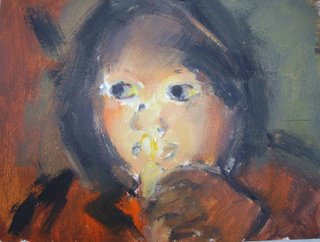|
|
Documentation: essay
Ghislaine Howard's 'work has a passionate roughness that seems sublimely right for the pain and confusion of the passion. The Stations should cry out to the viewer/prayer the meaning of human cruelty and our rejection of God's gentleness and love.' Sister Wendy Beckett
Historically, painting and sculpture in the Christian tradition has always had a powerful and significant didactic purpose: to educate a largely illiterate population through the force of pictorial visualisation. This sequence of paintings takes as its starting point a subject normally associated with Christianity and the European high art tradition and cuts to the core of its meaning, the suffering of a single, vulnerable human figure who could be any one of us, at any time or in any place. In these paintings much of the explicit Christian symbolism has been eschewed the better to focus the viewer’s attention firmly upon the essential features of this time-honoured narrative. The Stations of the Cross is a traditional sequence of images that are normally found in Roman Catholic churches. It follows the story of Christ's Passion, from his conviction to his execution and burial. The viewer is invited to empathise with Christ's suffering as he makes his way along the Via Dolorosa to Calvary, the place of his death. The Stations were developed by the Franciscan Brotherhood in the fourteenth century. They attempted to live their lives in direct emulation of Christ's life, especially those aspects that correlated most closely to the lives and aspirations of ordinary people. The Order had been charged with the protection of the Holy Places in Jerusalem and during the medieval period pilgrimage to the Holy Land, for the few who could manage it, was an important part of the Christian life. For those who couldn't make a pilgrimage certain activities could act as a substitute - a visit to Canterbury or Walsingham, for example, where they could re-enact the suffering of the Passion, usually as part of Good Friday processions. Part of their duty was to propagate the understanding and significance of Christ's life and teachings. The Stations could be set on wooden stands, carved with the story of each incident in Christ's Passion, placed either inside or outside the church. As the penitents paused at each Station, so they would hear a reading about that particular moment of Christ's journey and so they would be encouraged to empathise in the moment before moving on to the next. In an age when illiteracy was the norm, the Stations must have provided an extraordinarily vivid account of the most sacred part of Christ's earthly life, and acted as a means of fixing it in the believer's imagination thereby making it available for other exercises in piety. The number of the Stations at first varied widely, ranging from seven to over twenty-five. The present number of fourteen seems to have standardised in the Low Countries in the sixteenth century, and this was confirmed by Papal authority in 1731. In some cases, the church chose to emphasise the theological meaning of the Passion, by adding a fifteenth Station signifying the Resurrection. In this version the resurrection is absent, as its presence is symbolised by the Church itself. The Stations are based upon the accounts written in the four Gospels, but over the years incidents not present in the Bible have been added. The result of these additions is to make the narrative more resonant and effective to its intended audience. The paintings Ghislaine Howard was originally sponsored by Liverpool Hope University College to complete her series of paintings of the Stations of the Cross in 1999. Liverpool Hope worked in collaboration with Amnesty International and the whole project received the support of the North West Arts Board. The work was first exhibited together with a related series of paintings, the Witness figures, at the Anglican and Roman Catholic Cathedrals in Liverpool during the Easter season, 2000, and at Canterbury during Easter 2001. Since then they have been seen at a number of venues. Whilst being specifically Christian in content, the appeal of the subject matter is universal. The paintings are a representation of violence and suffering brought to bear upon the single, naked human figure. They are a pictorial and passionate response to the abuse of power that is most evident in the actions of repressive political and governmental régimes. We should not allow ourselves to be distanced from what this sequence represents: we should allow it to affect us, to make us angry, humble, complicit, and pained. This is a man; behold him. Whether Son of God or son of man is at once relevant and not; no power is lost in either reading. Howard's images of the Stations have been enthusiastically received by Amnesty International and the Medical Foundation for the Victims of Torture. It could be said that the artist's role as a witness to war, as propagandist or moral agent has become more and more difficult since the invention of photography. Photography posseses a vividness, a perceived closeness to the event recorded that a painting can never have and so it must make its impact through different means. But photography being so familiar to us, has perhaps lost some of its power to shock us into action. Ghislaine Howard's paintings are self-evidently what they are, vigorously applied pigment to canvas. After the immediacy of the initial encounter, the eye is invited to inch, not only across the encrusted pigment that lays on the surface of the canvas, but also along the Christ's body and to meditate on the tragic physical evidence of man's betrayal of his fellow man. In these paintings, Howard has chosen to eschew colour and picturesque detail, to work against facility because such things are inimical and irrelevant to her intentions -which is always to convey the significance of the story told. It is like the act she is depicting, an act of renunciation: to suppress anything that is not strictly necessary to interpretation, hence her use of grisaille, the monochrome images removing the images away from any sense of illusion in her determination to transform image into emblem. No distractions are allowed to remove the viewer from the immediacy of the event and to instigate active contemplation. The elimination of immediacy of the real makes space and time for 'recollection in tranquillity,' to meditate and consider, after first shock of recognition. The viewer is not seduced into a too easy emotional relationship with the work, and thereby is not given opportunity to dismiss or to reject the work through horror or shock, disapproval or repulsion. Instead it is to be hoped opportunity exists for a moral and ethical, emotional and reasoned response to the work and that which it represents. The long history of the Stations as a subject for artists has meant that many of the greatest names have produced versions of the subject, sometimes taking the whole narrative as their inspiration, sometimes concentrating as Rembrandt and Titian have done on one or other of the incidents. In the twentieth century artists as diverse as Eric Gill, Matisse, Barnett Newman and Rouault have treated the subject in its entirety, and that is only to mention those artists who are familiar to a general audience. In more recent years there has been a renewal of interest in the subject. It is a subject that may be interpreted in many different ways. The resurgence of interest in the subject parallels the renewed concern for figuration in contemporary art, along with the other developments that have been seen to typify twentieth century art, it is only recently that the trend to attempt to produce in an increasingly secular age an art based on what we can only call spiritual and humanitarian values has been evident. Although directly related to the Christianity, such images are not now the exclusive property of the Church, but can reach out into a broader community of interest. We live in a multi-cultural, pluralistic society, even during the Renaissance, Christian ideas were wedded to ideas and images inherited from classical Greece and Rome. Michael Howard 2001
|
Ghislaine Howard Studio Gallery
|
essay The Empty Tomb |



